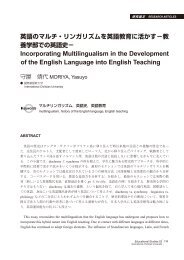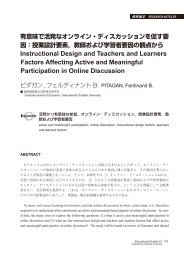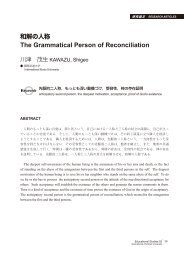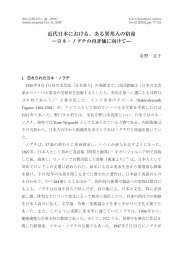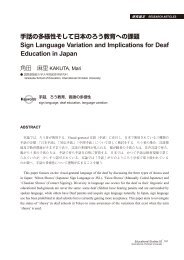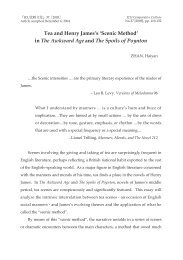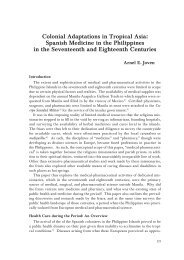Untitled - subsite - å½éåºç£æ大å¦
Untitled - subsite - å½éåºç£æ大å¦
Untitled - subsite - å½éåºç£æ大å¦
You also want an ePaper? Increase the reach of your titles
YUMPU automatically turns print PDFs into web optimized ePapers that Google loves.
: : 21<br />
Research Articles:Representing Sex and Sexuality: Requiem for Mother<br />
in his private domain. The hypocritical nature of social norms reinforced by bourgeois<br />
familial ideology in capitalist society only allows womens entrance into a mans world<br />
in so far as mourners are desperate to survive as social outcasts. The red lipstick, which<br />
the narrators wife drops in the soup on the mens table, symbolizes womens isolation<br />
and aborted rebellion in familial society.<br />
Creating a New Identity for a New Society<br />
Film often presents a female body as a metaphor of larger social problems (Douglas,<br />
1975). Associated with food, womens bodies, as providers, signify the object of basic<br />
human instincts and/or the sexual desires of men. Food is a universal symbol for the<br />
identification of human relations in changing societies amongst changing cultural<br />
values. Also, it plays a significant role in the deliberations of people upon their own<br />
identities in relation to others. The power of food is a symbol of self-identity [which]<br />
derives from the particular nature of the symbolic process involved (Ohmuki-Tierny,<br />
1996: 169). The female body in the absence of mothering powers invites male sadistic<br />
sexual desire and frustrates masculine gender identity in ultimate terms.<br />
The striking similarities in using food and the female body as a metaphor for the<br />
perplexity of human relations and repressed sexual desires are the prime references for<br />
this cross cultural analysis of the different representations of tradition and modernity<br />
in the four films. The comparative study of Park and Itamis work confirms that Parks<br />
films attempt to offer a serious cinematic critique regarding the repressive aspects of<br />
societys ideals pertaining to repressive familial relationships and womens inferiority.<br />
In comparison, Itamis internationally acclaimed films seem to be concerned with<br />
the voyeuristic pleasure of womens bodies or with the amusing behavior of the<br />
various characters in confused states, who desperately seek to position themselves as<br />
deserving members of various social institutions, including the family.<br />
The two directors representations of the co-existence of tradition and modernity in<br />
contemporary Japan and Korea can be summarized as follows. First of all, a comparative<br />
study conveys the different positionality of Korea and Japan in interpreting the past<br />
in reference to the changing needs of the people and their cultural norms. As Jan<br />
Vansina argues, tradition is a process; it lives only while it changes (1990: 251; Ohmuki-<br />
Tierny 1996: 169). Despite the ten-year gap between the films and the different paths



